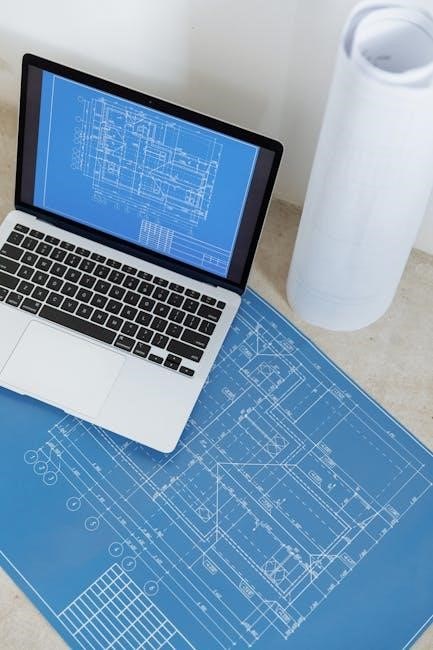Overview of Applied Statistics and Probability for Engineers
Applied Statistics and Probability for Engineers, 7th Edition, provides a practical approach to probability and statistical methods for engineering students. Covers probability distributions, statistical methods, and design of experiments. A valuable resource for engineers focusing on quality improvement and reliability engineering.
The 7th Edition of Applied Statistics and Probability for Engineers introduces significant improvements, including reorganized content and enhanced problem sets. It maintains a practical focus, blending probability and statistics with engineering applications. The authors have updated examples and included modern tools to reflect current practices. Designed for undergraduate engineering students, the text emphasizes clarity and accessibility, ensuring core concepts are easily understood. This edition also incorporates feedback from previous versions, refining explanations and adding real-world case studies. The result is a comprehensive resource that bridges theory and practice, making it indispensable for students and professionals alike. Its streamlined approach ensures readability while maintaining academic rigor, making it a cornerstone in engineering education.
Key Features of the Book
The 7th Edition of Applied Statistics and Probability for Engineers offers a robust set of features designed to enhance learning. It includes updated examples, modern tools, and revised problem sets to reflect current engineering challenges. The book is known for its clear, accessible writing style, making complex concepts understandable. A strong emphasis is placed on practical applications, with real-world case studies to illustrate key ideas. The text also features reorganized content for better flow and improved readability. Additional resources, such as solution manuals and online tools, support both students and instructors. This edition incorporates feedback from prior versions, addressing user needs and refining explanations. The result is a comprehensive, user-friendly resource that effectively blends theory with practical engineering scenarios.
Target Audience
The primary audience for Applied Statistics and Probability for Engineers, 7th Edition, is undergraduate engineering students, particularly those in fields like mechanical, industrial, and electrical engineering. It is also suitable for senior and graduate students seeking practical statistical knowledge. Professionals in engineering and related disciplines, such as quality management and reliability engineering, will find the book valuable for its real-world applications. The text is designed to be accessible to readers with a modest mathematical background, making it ideal for those new to statistics. Additionally, it serves as a comprehensive resource for practitioners needing to apply statistical methods in their work. The book’s clear explanations and practical focus make it a valuable tool for both students and professionals in engineering and applied sciences.

Key Topics Covered in the Book
Applied Statistics and Probability for Engineers, 7th Edition, covers probability distributions, statistical methods, design of experiments, quality control, and reliability engineering, providing a practical approach for engineers.
Probability and Probability Distributions
Probability and Probability Distributions form the foundation of statistical analysis in engineering. The book introduces key concepts such as random variables, probability mass functions, and cumulative distribution functions. It covers essential distributions like Bernoulli, Binomial, Poisson, Normal, and Weibull, explaining their properties and applications. Engineers learn to model real-world phenomena, such as component failures or process variability, using these distributions. Practical examples illustrate how to calculate probabilities and interpret distribution parameters. The section emphasizes understanding distribution selection and application in reliability engineering and quality management. Clear explanations and examples make complex concepts accessible, enabling engineers to apply probability theory effectively in problem-solving and decision-making scenarios. This chapter is crucial for building a strong statistical foundation for further topics in the book.
Statistical Methods and Data Analysis
Statistical Methods and Data Analysis are core components of the book, providing engineers with tools for data-driven decision-making. The text covers hypothesis testing, confidence intervals, regression analysis, and ANOVA. These methods enable engineers to analyze data, identify trends, and validate hypotheses. The book emphasizes practical applications, such as predicting process outcomes and optimizing system performance. Engineers learn to interpret data visualizations, residual plots, and diagnostic tools to ensure model accuracy. The section also addresses modern techniques like robust regression and non-linear modeling. By mastering these statistical methods, engineers can solve real-world problems efficiently, improving product quality and operational efficiency. The book’s focus on applied methods ensures that engineers are well-equipped to handle data analysis challenges in their professional roles. This chapter bridges theory and practice, making statistical methods accessible and actionable.
Design and Analysis of Experiments
Design and Analysis of Experiments is a critical chapter in the book, focusing on planning and interpreting experiments to improve engineering processes. It covers factorial designs, response surface methodology, and analysis of variance (ANOVA). Engineers learn to identify key factors affecting outcomes and optimize processes. The section emphasizes randomization, replication, and blocking to ensure experiment validity. Practical examples demonstrate how to apply these methods in real-world scenarios, such as product development and quality improvement. The chapter also introduces advanced techniques like robust design and Taguchi methods. By mastering experimental design, engineers can systematically approach problem-solving, leading to more efficient and reliable solutions. This section bridges statistical theory with practical engineering applications, making it invaluable for process optimization and innovation.
Quality Control and Improvement
Quality Control and Improvement is a central focus of the book, emphasizing statistical methods to enhance product and process quality. It covers tools like control charts, process capability analysis, and Six Sigma methodologies. Engineers learn to monitor and improve processes, reduce variability, and ensure compliance with quality standards. The section integrates statistical techniques with practical applications, such as identifying and addressing defects. Case studies illustrate real-world implementations of quality control systems. The chapter also explores modern approaches like lean manufacturing and total quality management. By applying these methods, engineers can systematically improve productivity and customer satisfaction. This section equips readers with the skills to implement effective quality control strategies in diverse engineering environments, ensuring reliability and consistency in outcomes.
Reliability Engineering and Risk Analysis
Reliability Engineering and Risk Analysis focuses on methods to assess and optimize system reliability and minimize operational risks. The chapter discusses failure modes, hazard analysis, and reliability testing. It introduces probabilistic models to predict system failures and evaluates risk using statistical tools. Engineers learn to design robust systems and manage uncertainties. The section also addresses maintenance strategies and fault-tolerant designs. Real-world examples demonstrate how these techniques improve system performance and safety. By applying these methodologies, engineers can enhance product durability and reduce the likelihood of failures. This section provides essential insights for ensuring the dependability of engineering systems across various industries, making it a crucial component of modern engineering practices.

Authors and Their Contributions
Douglas C. Montgomery and George C. Runger are renowned experts in statistics and engineering. They co-authored the 7th edition, enhancing it with modern methods and practical applications.
Douglas C. Montgomery
. His work emphasizes practical applications of statistical methods in engineering, making complex concepts accessible to students and practitioners. In the 7th edition of Applied Statistics and Probability for Engineers, Montgomery collaborated with George C. Runger to update and enhance the content, ensuring it remains a leading resource for engineering education. His contributions have shaped the way engineers approach data analysis, quality control, and experimental design.
George C. Runger
George C. Runger is a distinguished professor and researcher in the field of industrial engineering and statistics. Alongside Douglas C. Montgomery, he co-authored the widely acclaimed Applied Statistics and Probability for Engineers, now in its 7th edition. Runger’s expertise lies in statistical methods, process control, and experimental design. His contributions to the book have been instrumental in bridging the gap between theoretical statistics and practical engineering applications. Runger’s work emphasizes the importance of data-driven decision-making and has influenced generations of engineers. The 7th edition reflects his commitment to updating content with modern engineering challenges, ensuring it remains a vital resource for both students and professionals. His collaborative approach with Montgomery has solidified the book’s reputation as a cornerstone in engineering education.
Collaborations and Acknowledgments
The 7th edition of Applied Statistics and Probability for Engineers reflects contributions from various collaborators and acknowledges the support of academic colleagues and industry professionals. The authors recognize the input of numerous reviewers and practitioners who provided feedback to enhance the book’s clarity and relevance. Students and instructors who shared insights into teaching and learning experiences were instrumental in shaping the content. Collaborations with experts in reliability engineering and quality control added depth to specific chapters. Acknowledgments extend to editorial and publishing teams at Wiley for their meticulous work in ensuring the book’s quality and accessibility. The collective effort underscores the book’s commitment to bridging theory and practice, making it a trusted resource for engineering education.

Editions and Updates
The 7th Edition of Applied Statistics and Probability for Engineers introduces enhanced content organization, updated examples, and expanded coverage of modern engineering applications, ensuring relevance and clarity for students and practitioners alike.
7th Edition vs. Previous Editions
The 7th Edition of Applied Statistics and Probability for Engineers offers significant improvements over earlier versions. It includes a reorganized structure for better flow, with updated chapters on modern engineering applications. Enhanced coverage of reliability engineering and quality control is provided, reflecting current industry practices. New examples and case studies have been added to illustrate key concepts, making the content more engaging and relevant for students. The mathematical level remains modest, ensuring accessibility while maintaining depth. Compared to previous editions, the 7th Edition places greater emphasis on practical problem-solving, aligning with the needs of both undergraduate students and practicing engineers. These updates ensure the book remains a leading resource in the field of engineering statistics.
New Features in the 7th Edition
The 7th Edition of Applied Statistics and Probability for Engineers introduces several new features to enhance learning. It includes updated examples and case studies to reflect modern engineering challenges. The book incorporates new chapters on reliability engineering and advanced quality control methods, providing deeper insights into these critical areas. Additionally, the 7th Edition offers improved illustrations and graphs to better visualize complex concepts. The authors have also expanded the coverage of statistical software tools, enabling students to apply theoretical knowledge practically. Furthermore, the book includes new problem sets and exercises to reinforce understanding. These enhancements make the 7th Edition more comprehensive and user-friendly, catering to both students and professionals in the field of engineering. The updates ensure the content remains relevant and aligned with current industry standards and practices.
Reorganization of Content

The 7th Edition of Applied Statistics and Probability for Engineers features a significant reorganization of content to improve clarity and accessibility. Key chapters have been streamlined, with a focus on logical flow from foundational concepts to advanced applications. The book now begins with probability distributions, followed by statistical methods, ensuring a sequential learning experience. New chapters on reliability engineering and quality control have been added, while existing chapters have been updated to reflect modern engineering practices. The reorganization enhances readability and ensures that students and professionals can easily navigate the material. This structural overhaul aligns with the goal of providing a practical, applied approach to statistics and probability in engineering contexts; The revised layout is designed to facilitate better understanding and retention of key concepts.

Learning Resources and Supplements
The 7th Edition offers solution manuals, study guides, and online resources to enhance learning. Supplementary materials for instructors, including lecture slides and test banks, are also available.
Solution Manuals and Study Guides
The 7th Edition provides comprehensive solution manuals and study guides to aid students in mastering key concepts. These resources include detailed solutions to textbook problems, chapter summaries, and practice exercises. The solution manual offers step-by-step explanations for complex problems, enabling students to understand and apply statistical methods effectively. Study guides are designed to reinforce learning, with additional examples and exercises tailored to each chapter. Both resources are available in digital formats, making them accessible for self-study. Instructors can also utilize these materials to create homework assignments or quizzes. Overall, these supplements enhance the learning experience, ensuring a deeper understanding of applied statistics and probability for engineering applications. They are indispensable tools for both students and educators.
Online Resources and Tools
The 7th Edition of Applied Statistics and Probability for Engineers is supported by a range of online resources and tools, enhancing the learning experience. Students and instructors can access interactive simulations, data analysis tools, and digital versions of the textbook. The companion website offers downloadable datasets, enabling hands-on practice with real-world problems. Additionally, online platforms provide self-assessment quizzes and interactive exercises, allowing students to test their understanding. Instructors benefit from password-protected resources, including lecture slides and customizable test banks. These digital tools are designed to complement the textbook, fostering a dynamic and engaging learning environment. They ensure that students gain practical skills in statistical analysis and probability, preparing them for challenges in engineering and related fields.
Supplementary Materials for Instructors
Instructors using the 7th Edition of Applied Statistics and Probability for Engineers have access to a wealth of supplementary materials. These include detailed solution manuals for homework problems, enabling instructors to effectively grade assignments and provide feedback. Lecture slides and presentation materials are also available, helping instructors deliver course content in an organized and visually engaging manner. Additionally, instructors can access customizable test banks, allowing them to create exams tailored to their specific course objectives. These resources are designed to support instructors in preparing and delivering courses, ensuring a comprehensive and effective learning experience for students. The materials are often provided in digital formats, making them easily accessible and adaptable for various teaching styles and classroom environments;

Applications in Engineering Fields
Applied Statistics and Probability for Engineers is widely used in manufacturing, quality management, and reliability engineering. It aids in improving process efficiency, ensuring product quality, and minimizing risks in industrial settings.

Manufacturing and Industrial Engineering
In manufacturing and industrial engineering, Applied Statistics and Probability for Engineers provides essential tools for process optimization and quality improvement. Statistical methods enable engineers to analyze production data, identify trends, and implement efficient solutions. The book emphasizes the use of control charts and experimental design to enhance manufacturing processes, ensuring high-quality outputs and minimal defects. By applying probability concepts, engineers can predict and mitigate risks in production lines, leading to increased productivity and cost savings. These techniques are vital for maintaining competitiveness in modern industrial environments.
The 7th edition further refines these applications, offering practical examples and case studies tailored to real-world manufacturing challenges. This makes it an invaluable resource for both students and practicing engineers aiming to improve industrial processes and systems.
Quality Management Systems
Applied Statistics and Probability for Engineers, 7th Edition, plays a pivotal role in quality management systems by providing statistical tools to monitor and improve process performance. Engineers learn to apply control charts, capability analysis, and experimental design to identify trends, reduce variability, and enhance product quality. The book emphasizes the integration of statistical methods with quality management frameworks, such as Six Sigma, to achieve operational excellence. By leveraging probability concepts, engineers can predict and mitigate risks in manufacturing processes, ensuring compliance with quality standards. These techniques are essential for implementing data-driven decision-making in quality management systems.

The 7th edition includes updated examples and case studies, making it a comprehensive resource for engineers aiming to optimize quality management practices and achieve continuous improvement in industrial settings.
Reliability and Maintenance Engineering

Applied Statistics and Probability for Engineers, 7th Edition, offers comprehensive insights into reliability and maintenance engineering. Engineers learn to apply statistical methods to predict system failures, optimize maintenance schedules, and enhance overall reliability. The book introduces techniques like failure mode analysis and reliability modeling, enabling engineers to assess and mitigate risks in complex systems. Probability distributions, such as the Weibull distribution, are discussed in detail to analyze failure data and improve system performance. These tools are essential for ensuring long-term operational efficiency and reducing downtime in industrial applications. The 7th edition includes updated methodologies and real-world examples, making it an invaluable resource for engineers focused on reliability and maintenance engineering.
By integrating statistical approaches, engineers can design more robust systems and implement proactive maintenance strategies.
The 7th edition of Applied Statistics and Probability for Engineers is a comprehensive resource for engineering education. It bridges theory and practice, aiding engineers in problem-solving and data-driven decision-making. The book’s practical approach, updated content, and real-world applications make it indispensable for modern engineering. Future editions could further emphasize emerging technologies like AI and machine learning, enhancing its relevance in a rapidly evolving field.
Importance of the Book in Engineering Education
Applied Statistics and Probability for Engineers, 7th Edition, is a cornerstone in engineering education, providing a practical understanding of statistical methods and probability. It bridges the gap between theoretical concepts and real-world applications, making it indispensable for undergraduate and graduate students. The book’s focus on engineering-specific problems enables learners to apply statistical techniques to design experiments, quality control, and reliability engineering. Its clear explanations and modest mathematical level ensure accessibility for students from diverse engineering disciplines. By emphasizing data-driven decision-making, the book prepares engineers to tackle complex challenges in industries like manufacturing, industrial engineering, and reliability management. Its comprehensive coverage and practical orientation make it a standard textbook in many engineering programs worldwide.
Recommendations for Future Editions
Future editions of Applied Statistics and Probability for Engineers could benefit from enhanced coverage of emerging topics like machine learning and big data analytics. Incorporating more real-world case studies from diverse engineering fields would further strengthen practical understanding. Additional interactive tools or simulations could be included to aid visual learning. Expanding the discussion on reliability engineering and risk analysis would align with growing industry demands. Furthermore, providing more detailed explanations for complex mathematical derivations would enhance accessibility for students. Including supplementary materials, such as video lectures or online problem-solving platforms, could enrich the learning experience. Ensuring the content remains aligned with evolving engineering standards and technologies will solidify its role as a leading educational resource.
Final Summary
Applied Statistics and Probability for Engineers, 7th Edition, is a comprehensive resource that bridges theory and practice, making it indispensable for engineering education. Its clear presentation of probability, statistical methods, and experimental design equips students and professionals with essential tools for data-driven decision-making. The book’s focus on real-world applications in fields like manufacturing, quality control, and reliability engineering ensures its relevance to contemporary challenges. With updates reflecting modern methodologies, it remains a cornerstone for understanding statistical principles in engineering. Its accessible approach and robust content make it a valuable investment for anyone seeking to master applied statistics and probability in engineering contexts.
